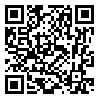Volume 9, Issue 36 (2016)
LCQ 2016, 9(36): 165-186 |
Back to browse issues page
Download citation:
BibTeX | RIS | EndNote | Medlars | ProCite | Reference Manager | RefWorks
Send citation to:



BibTeX | RIS | EndNote | Medlars | ProCite | Reference Manager | RefWorks
Send citation to:
Gholamy F. Manifestation of Theory in Theorist’s Works: The Examination of “The Reader in the Book” in Kissing Game by Aiden Chambers. LCQ 2016; 9 (36) :165-186
URL: http://lcq.modares.ac.ir/article-29-7760-en.html
URL: http://lcq.modares.ac.ir/article-29-7760-en.html
1- Master of Arts in English Literature, Razi University of Kermanshah
Abstract: (9502 Views)
Abstract
In recent years in Iran, Aiden Chambers’ theory called “The Reader in the Book” has greatly attracted researches in the realm of children literature. The purpose of such studies has been to read various works of Iranian children literature writers based on Chamber’s theory. In order to recognize the specifics of the child reader in the text, Chambers introduces the four essential elements of style, point of view, taking sides and tell-tale gaps. The fundamental question of this study is to examine whether the theoretical elements and concepts chambers names as essential to create the child reader in the book are practically used in his literary works? The examination of “Cindy’s Day Out” from his collection, Kissing Game, represents that Chambers has created an active and critical child reader in his work through the proper application of different methods, such as the shift from narratorial-descriptive style to dramatic-objective style, Various but fluid and friendly diction, few but understandable literary figures, third person narrator focalized through the main character, taking sides through style shift, superficial and cultural gaps along with gaps in characterization and narrative structure.
In recent years in Iran, Aiden Chambers’ theory called “The Reader in the Book” has greatly attracted researches in the realm of children literature. The purpose of such studies has been to read various works of Iranian children literature writers based on Chamber’s theory. In order to recognize the specifics of the child reader in the text, Chambers introduces the four essential elements of style, point of view, taking sides and tell-tale gaps. The fundamental question of this study is to examine whether the theoretical elements and concepts chambers names as essential to create the child reader in the book are practically used in his literary works? The examination of “Cindy’s Day Out” from his collection, Kissing Game, represents that Chambers has created an active and critical child reader in his work through the proper application of different methods, such as the shift from narratorial-descriptive style to dramatic-objective style, Various but fluid and friendly diction, few but understandable literary figures, third person narrator focalized through the main character, taking sides through style shift, superficial and cultural gaps along with gaps in characterization and narrative structure.
Keywords: "Children Literature, " "Aidan Chambers, " "The Reader in the Book, " "Kissing Game, " “Cindy’s Day Out”
Article Type: practical |
Subject:
Street literature
Received: 2016/06/30 | Accepted: 2016/12/21 | Published: 2017/01/27
Received: 2016/06/30 | Accepted: 2016/12/21 | Published: 2017/01/27
| Rights and permissions | |
 |
This work is licensed under a Creative Commons Attribution-NonCommercial 4.0 International License. |








